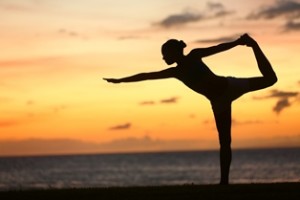Even during those summer days, waking up can be a nightmare especially when it’s early, but what do you do when you wake up? Think about it, the first thing you do is stretch to wake up your muscles. Stretching your muscles is and should be a part of your everyday physical activity and/or exercise.
If your body is getting its preparation, what about your mind? Is there an exercise that prepares your body as well as your mind? Well, there is! You all have heard of yoga, right? Yoga is an exercise and meditation activities that helps you unite your mind and body. It uses techniques or poses to help with your posture, flexibility, and strength. It also teaches you how to breathe during the practice of these particular exercises.
Before we go on to the physical part, let’s talk about the meditation (or the mind exercise) that happens before or during your practice of yoga. Meditation is not always a religious practice; it’s a way of getting your mind together whether you’re contemplating your spirituality or how to make your kids eat their vegetables. It’s a way to get in touch with your body as well. Remember how we always say get to know your body? Meditation can help you with that during the poses in yoga.
When or if beginning yoga for the first time, you may not find it easy for your body and you may discover new things about your body. For instance, you may discover poses that you like or poses you don’t like. This depends on how the poses feels to your body. It also shows you where and how you need to improve physically. It’s challenging but yoga is a progressive exercise practice. When we say “practice,” we mean with more practice comes more improvement. You’ll find, over time, those uncomfortable poses won’t be so uncomfortable anymore.
Yoga inspires stretching and positioning your body in ways that will improve your flexibility. It also encourages you to use muscles you haven’t used or never knew you had. When your yoga instructor directs you to take a specific pose or certain posture, it conjures those dormant muscles. Over time, they build and tone. For instance, the use of good posture strengthens your core muscles.
If you’re looking for a way to become one with yourself (an exercise for your mind and body), and to progressively improve your fitness (flexibility and strength), give yoga a try. It may be one of the best ways to exercise for you.
The EE 411: For the Newbies 
There are a few things that beginners should keep in mind when starting yoga: (1) how do I prepare for yoga and (2) what type of yoga do I like or is best for me?
How do I prepare for yoga?
- Determine if yoga is right for you by checking with your doctor. Medical considerations like hip surgery or pregnancy should be taken into account. Although, it is recommend that those expecting should not practice yoga—still consult a professional.
- Keep Hydrated. This is important in general! This is also really important if you are thinking about practicing Hot Yoga or Bikram.
- Eat. A rational meal two to three hours before practicing will give you energy to put forth the necessary effort.
- Know your limits. Do not perform a task just because everybody else in the class can. If you cannot do it, do not push it to the limit. Do what your body is prepared for; in time your flexibility and strength will improve. Also, know what time of day you are more flexible. For instance if you are your stiffest in the morning, morning yoga classes may not be the best for you.
- Warm up! Pre-stretches for ten or fifteen minutes help ready your body for the work it’s going to put in during yoga.
What type of yoga do I like or is best for me?
- Anusara- Popular and designed in the US, this type of yoga inspires elegance with a focus on alignment.
- Ashtanga- This style encompasses a series of postures with matching breathing. It is a physically demanding work out, so bring a towel.
- Bikram –This yoga is heated, literally. It takes place in an artificially heated room. It consists of 26 poses in a sequence. You will sweat—this is another towel demanding yoga practice.
- Hatcha- This is a generic, universal form of yoga. It is one of the common practices and is generally used for introduction because of its gentle style and more relaxed environment.
- Hot Yoga- Do not forget your towel! It is similar to Bikram except the sequence of the poses is different, but the room is still heated.
- Iyengar- this yoga practice is scrupulous and requires you to pay the utmost attention to detail. It requires configuration in your poses. It also summons the use of props during the practice. It requires plenty of discipline and is not for the faint hearted or fidgety.
- Restorative- Do you consider yourself a nervous person? This yoga works to relax and calm the nerves. This yoga also uses props like blankets and instructs the students to take less disciplined poses. It requires less effort and restores your body to its proper balance.
- Vinyasa- If you like to dance this may be the yoga for you. Its practice is to incorporate more harmonious movements that are sequenced to flow smoothly. However, the sequences are almost never the same. So, it is less consistent.
Share with Us: What type of yoga do you practice and why?
(This post was brought to you by Earth’s Enrichments. Similar posts can be found by visiting our Blog. More information about our company and products (USDA Certified Organic Soaps, Organic Bath Salts, Organic Sugar Scrubs, Organic Body Balms and Organic Lip Balms) can be found on our Website. Thank you Earth’s Enricher!)


